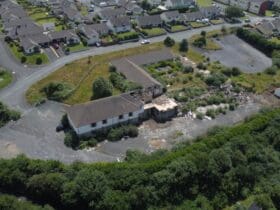RCT’s Cabinet has agreed to extend the RCT Empty Homes Strategy before the Council adopts an updated version next year – with the positive work over the last two years helping to bring 501 empty properties back into use.
At their meeting on Monday, October 18, Cabinet Members received an update on the current Strategy, which runs from 2018 to 2021 and implements the Council’s approach to tackle the problem of empty homes. Members have now agreed to extend it until March 2022, noting that an updated Strategy is currently being developed by Officers for implementation during April 2022.
The report also notes the positive work delivered and the outcomes achieved under the Strategy over the past two years, despite the pandemic.
The objectives to help reduce empty homes in Rhondda Cynon Taf include developing partnerships, maximising the use of funding and identifying further models, and using a range of interventions against property owners. They also include community research to understand why empty property numbers are high, and identifying solutions to prevent homes from becoming empty.
The report notes that the Council has delivered 1,144 interventions over the past two years (above the target of 400 per year), helping to bring 501 properties back into use. Interventions can range from a number of actions, including enforcement, issuing advice or guidance, and assisting with grants or loans.
These actions have helped the overall number of empty properties in Rhondda Cynon Taf reduce from 3,556 (April 2017) to 2,870 – a reduction by 19% or 686 properties. These figures combine the Council’s work, with those empty properties brought back into use without Council involvement.
The report notes the actions over the past two years which have contributed to this improved position. This included the Council identifying 684 of the most problematic, long-term empty homes to be the focus of enforcement and enabling activity, as they are recorded as being empty since 2014. Of these, 510 received inspections, while all owners were sent letters offering assistance or, if necessary, outlining enforcement action.
In total, 297 of these most problematic long-term properties are now back in use. Also, an additional 91 properties were brought back into use without intervention since April 2018 – when the Council introduced a policy that owners of long-term empty dwellings in Rhondda Cynon Taf receive no discount on their Council Tax bill.
The Welsh Government-funded Houses into Homes Loan has also been very successful, for applicants who want to rent or sell their property on completion of refurbishment works. As of April 2021, 126 loans (totalling £3.7m) have been approved, creating 175 homes from privately-owned empty properties.
The Council has also led on the £10m Valleys Taskforce Empty Homes Grant – made available to prospective owners who intend to occupy an empty home as their main residence for a minimum five-year period. As of March 2021, 941 valid applications received from across Wales, of which 494 were from the Rhondda Cynon Taf area, resulting in £5.5m of funding being committed locally.
Finally, 22 empty properties were brought back into use via the Homestep Plus Scheme, in partnership with United Welsh Housing Association. Properties in the CF37 postcode area are bought and renovated under this Scheme, and then sold to first-time buyers at 70% of the market value.
Councillor Robert Bevan, Rhondda Cynon Taf Council’s Cabinet Member for Enterprise, Development and Housing, said: “The report considered by Cabinet on Monday provided very positive news about the decreasing number of empty homes in Rhondda Cynon Taf, thanks to the dedicated work of Officers, adhering to the RCT Empty Homes Strategy over the past two years.
“This issue remains an important priority for the Council, as privately-owned empty homes have many disadvantages. They are a financial expense to owners and the Council, and, in many cases, a missed opportunity to provide affordable housing locally. Empty properties are also more likely to be left to deteriorate, having a negative impact on the appearance of communities.
“I’m delighted that 501 empty properties have been brought back into use due to Council intervention – whether that’s offering advice and support to owners, helping them access funding, or through enforcement action. The introduction of full Council Tax rates for empty properties has also had its intended effect – encouraging owners to bring them back into use. These factors have helped improve the overall picture, with 686 fewer properties now empty.
“Further contributing to this progress has been the success of a number of schemes and initiatives, in which the Council plays a key role – including the Houses into Homes Loan, the Valleys Taskforce Empty Homes Grant and the Homestep Plus Scheme. Also, with more than 40 property owners regularly attending the RCT Landlord Forum, it provides an excellent opportunity for the Council to engage with landlords, share information and work together.
“Cabinet Members agreed with the recommendations of the report, to extend the current RCT Empty Homes Strategy until March 2022 – in readiness for an updated version of the Strategy to be implemented during April 2022.”









Leave a Reply
View Comments